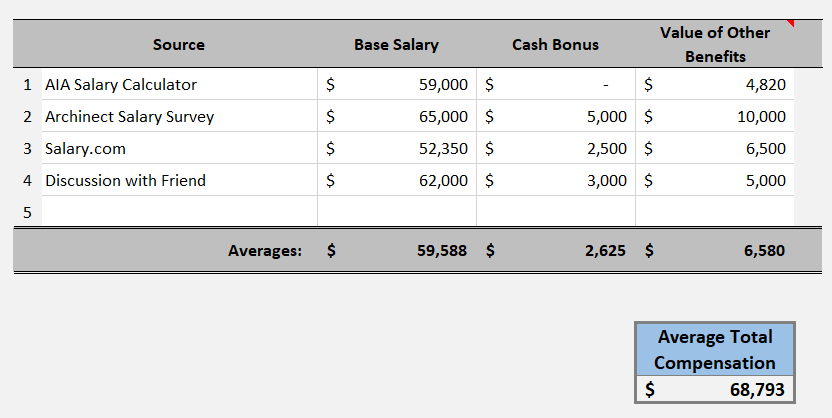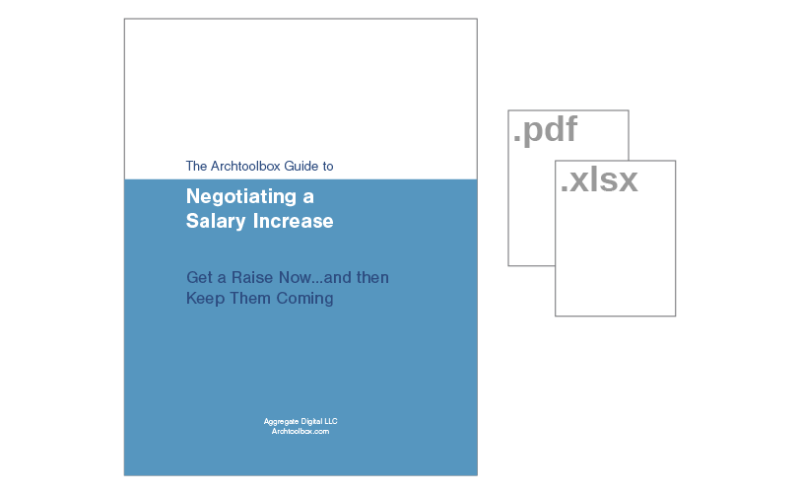For those wanting a more detailed approach, we offer The Archtoolbox Guide to Negotiating a Salary Increase in the Archtoolbox Store. The guide leads you through the entire process in more detail than this article covers.
Asking for a raise can be an intimidating thing to do for employees of any age. According to payscale.com, fewer than 50% of people ask for a raise. People cite a fear of seeming pushy, greedy, or annoying their boss. Others are simply uncomfortable talking about money and asking for more, even if they are underpaid. Many people believe their boss should give them the raise they deserve without having to be asked. Unfortunately, it doesn't work that way.
You need a few things in order to be successful in asking for a raise:
- Contributions to your projects and firm that are more valuable than what they are paying you
- Market research showing that you are underpaid
- Confidence to calmly, but convincingly, ask for more money
Number 1 takes some time to create but should be the focus of every architect at every firm. Number 2 is pretty easy to find online. And number 3 should be easier to generate if you already know you have the first two nailed down.
Determine What Your Firm Values and Provide It
That sure sounds simple, doesn't it?
As salespeople know, you will have a lot of success if you can provide $2 of value and charge your client $1 for it. Much like in sales, you should be trying to provide your firm with more value than you receive in compensation. The goal is to keep the scale tilted ever-so-slightly in their direction so they always feel like they are getting more from you than they are paying you.
Even though most architects aren't in it for the money, firms are looking to maintain a positive bottom line. That means the more money you can help your firm make, the more money your firm will pay you. Yes, this also applies to high-design firms (they sell clients a certain level of quality design, which helps attract other clients who want the same type of building).
Spend some time thinking about where you provide the most value. Is it by generating interesting design ideas? Or managing a client's challenging groups of users? Or working with a contractor to execute a complicated design? Or perhaps you are able to manage an office full of quirky personalities. Of course, the ultimate value is in leveraging relationships to bring new projects to the firm.
There are plenty of ways to create value – find yours and focus on that each day.
Market Research Will Show You How Much You Are Worth
Once you understand the value you offer, the next step is to find out what the market says those skills are worth. There are a few helpful databases to get you started including the AIA Compensation Report Salary Calculator, which uses data from their bi-annual salary survey. The Archinect Architecture Salary Poll is also a helpful resource for establishing a market rate for your work. Finally, traditional job websites can help but aren't dedicated to architecture and design professions.

Be sure you evaluate market salaries based on a similar job description in your city. You'll have to make adjustments based on an honest evaluation of your performance and value provided. In addition, economic factors can affect salaries so you'll have to consider how busy your firm is and how well they are performing financially. The hardest part is to remain neutral. Remember, by definition we cannot all be above-average performers at an above-average firm.
Once you've established what the market will pay for your services you should take some time to create a backup plan. Unfortunately, there is no guarantee that you'll get a raise even if the market says you are underpaid. You should have alternative requests in mind in case your original request is denied. Some options include more vacation, flexibility in scheduling, less travel, or special stipends.
Make The Ask
First, determine when your firm makes salary increase decisions and then look to plan a meeting a couple of weeks before that time. Firms generally adjust salaries at the end of the calendar year, at the end of their fiscal year, or on employment anniversaries. Once you have a timeframe, chose one or two people who make salary decisions and who work closely with you and invite them to a meeting. It is best to have the discussion in a place where they won't be distracted so they can focus on your discussion.
As goofy as it is to practice out loud or in front of a mirror, it will help you feel more at ease and more confident. Practice your introduction to the conversation. In addition, practice the formal request so you are relaxed when the time comes. It may be helpful to practice with a friend or loved one so they can suggest improvements in your presentation.
Remember, THIS IS NOT ABOUT YOU. Yes, you are asking for a raise because you want more money. However, you should focus your discussion around the value you bring to the firm. If you can demonstrate that you help them make more money, then they should be happy to offer you a portion of that in compensation. If you make their daily lives easier you should subtly remind them of that.
And of course, have that backup plan ready to go in case things don't work out well. If you aren't given a raise, try to find out the reason behind being declined – this will be useful information when you are ready to make a future request. Gather as much info as you can by being genuinely curious about the process and their challenges during salary negotiations. Ask them what you can do to be in a better position next time.
Prepare for Next Year
Receiving a raise (or being declined) isn't the end of the story. Now, it is time to prepare for next year.
Be sure to take detailed notes immediately after your discussion. Write down any information you learned that might help you be better prepared for next year. It is likely that you received some solid hints at what you need to improve upon to be in a position to get a salary bump the next time they are offered. Start working on those improvements today and review your notes on occasion so you keep improving over the year.
In addition, go back to the first section of this article and really think about how you can provide more value to the firm and the firm leaders. Develop a plan to help make yourself better. Ask for input from firm leaders. Remember, you can accomplish a lot in a year. Dedicate yourself to doing the best work possible and look to make a positive impact on your office every day.
A Complete Guide to Negotiating a Salary Increase
If you want a detailed guide that takes you through the entire process from beginning to end, check out our Guide to Negotiating a Salary Increase, which is written specifically for architects and other design professionals. The 49-page PDF guide includes exercise and worksheets that help you determine what you should be paid and then how to ask for the raise. Check it out in the Archtoolbox Store.



